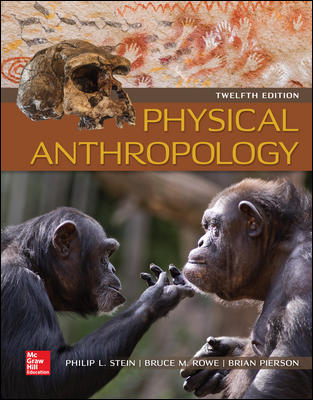Description
Test Bank For Physical Anthropology 12th Edition by Philip Stein
Chapter 03
The Modern Study of Human Genetics
Multiple Choice Questions
1. A single nucleotide polymorphism (SNP) refers to:
A. an error in the genetic code involving the replacement of multiple proteins by a single protein
B. the presence of only a single allele of a gene
C. an error in the genetic code involving a single change of a nucleotide at a particular point
D. the presence of a dominant allele and a recessive allele of a single gene
Accessibility: Keyboard Navigation
2. How many major alleles does the ABO blood-type system have?
A. one
B. two
C. three
D. four
E. more than four
Accessibility: Keyboard Navigation
3. The hemoglobin molecule is composed of four chains of amino acids: two alpha chains and two beta chains. The start of the code of the beta chain is GTGCACCTGACTCCTGAG. This codes for the first six amino acids of this chain: valine-histidine-leucine-threonine-proline-glutamic acid. If a single nucleotide polymorphism (SNP) occurs in the code for glutamic acid, which of the following will be a consequence of the SNP?
A. it will result in a different amino acid replacing glutamic acid
B. it will result in glutamic acid replacing all six amino acids at the start of the beta chain
C. it will result in the amino acids present after glutamic acid in the beta chain being replaced by different amino acids
D. it will result in glutamic acid replacing all amino acids in the beta chain
Accessibility: Keyboard Navigation
4. Phenylketonuria (PKU) is an inherited:
A. skeletal abnormality
B. blood disorder
C. metabolic abnormality
D. psychiatric disorder
Accessibility: Keyboard Navigation
5. Ashkenazi Jews:
A. are the only population to carry the allele for Tay-Sachs disease
B. have a high carrier rate for Tay-Sachs disease
C. have the lowest carrier rate for Tay-Sachs disease
D. may have a high carrier rate for Tay-Sachs disease but also possess a regulator gene that prevents the disease from expressing itself
Accessibility: Keyboard Navigation
6. Achondroplastic dwarfism in humans is inherited as:
A. a result of a dominant allele
B. a lethal recessive
C. an X-linked trait
D. a recessive
Accessibility: Keyboard Navigation
7. Which of the following is a late-onset genetic disease characterized by the loss of motor control associated with jerky movements and psychiatric symptoms?
A. Klinefelter syndrome
B. Turner syndrome
C. Tay-Sachs disease
D. Huntington’s disease
Accessibility: Keyboard Navigation
8. Which of the following is true of Huntington’s disease?
A. it is a result of excessive GGG repeats
B. it is a result of excessive CAG repeats
C. it is inherited in a codominant pattern
D. it is inherited in a recessive pattern
Accessibility: Keyboard Navigation
9. A Punnett square is a grid used in genetics to:
A. show the genotypes and their probabilities of a particular gene in a mating
B. show the probability of occurrence of the actual phenotypes for a particular gene
C. calculate the frequency of a genetic abnormality in a population
D. calculate the frequency of a particular phenotype in a population
Accessibility: Keyboard Navigation
10. A child is diagnosed with Tay-Sachs disease. Both the father and mother are carriers (heterozygous for the disorder). Using the Punnett square, it can be estimated that the probability of them having a phenotypically normal child is:
A. 1/4
B. 2/4
C. 3/4
D. 4/4
Accessibility: Keyboard Navigation
11. A couple has a child who is diagnosed with Tay-Sachs disease. Both the father and mother are carriers (heterozygous for the disorder). Using the Punnett square, it can be estimated that the probability of them having a child with Tay-Sachs disease is:
A. 1/4
B. 2/4
C. 3/4
D. 4/4
Accessibility: Keyboard Navigation
12. Deviations from Mendelian genetics include:
A. polygenic inheritance
B. multiple-allele series
C. pleiotropy
D. all of these
Accessibility: Keyboard Navigation
13. Which of the following genetic abnormalities shows the symptoms of excessive mucus production, digestive and respiratory failure, and reduced life expectancy?
A. achondroplastic dwarfism
B. beta-thalassemia
C. cystic fibrosis
D. Tay-Sachs disease
Accessibility: Keyboard Navigation
14. In the context of deviations from Mendelian genetics, polygenic inheritance refers to:
A. a specific trait being influenced by more than one gene
B. both alleles being expressed in a heterozygous genotype
C. three or more alleles existing for a specific gene
D. a gene altering the expression of another gene
Accessibility: Keyboard Navigation
15. In the context of deviations from Mendelian genetics, codominance refers to:
A. the influence of nongenetic factors on a phenotype
B. both alleles being expressed in a heterozygous genotype
C. three or more alleles existing for a specific gene
D. a gene altering the expression of another gene
Accessibility: Keyboard Navigation
16. In the context of deviations from Mendelian genetics, incomplete penetrance refers to:
A. the influence of nongenetic factors on a phenotype
B. the situation in which an allele that might be expected to be expressed is not
C. a single allele affecting an entire series of traits
D. a gene altering the expression of another gene
Accessibility: Keyboard Navigation
17. Oncogenes refer to genes with alleles that:
A. contribute to the development of cancers
B. prevent the expression of cancer-causing genes
C. are unaffected by mutation
D. behave as dominant alleles
Accessibility: Keyboard Navigation
18. A sex-limited gene is:
A. one that is carried on the Y chromosome
B. one that is carried on the X chromosome
C. one that is carried on either the X or Y chromosome
D. expressed in only one of the sexes
Accessibility: Keyboard Navigation
19. The Y chromosome:
A. carries the gene that establishes the sex of the individual
B. carries very few genes
C. is found only in genetic males
D. all of these
Accessibility: Keyboard Navigation
20. Ways of determining the sex of an individual include:
A. phenotypic sex
B. chromosomal sex
C. genetic sex
D. all of these




Be the first to review “Test Bank For Physical Anthropology 12th Edition by Philip Stein”